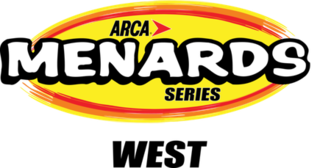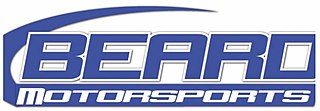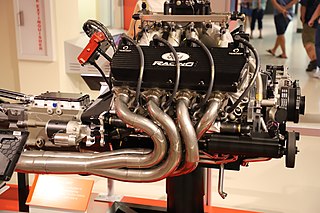
Stock car racing is a form of automobile racing run on oval tracks and road courses measuring approximately 0.25 to 2.66 miles. It originally used production-model cars, hence the name "stock car", but is now run using cars specifically built for racing. It originated in the southern United States; its largest governing body is NASCAR. Its NASCAR Cup Series is the premier top-level series of professional stock car racing. Australia, Canada, New Zealand, Mexico, Brazil, Argentina, and the United Kingdom also have forms of stock car racing. Top-level races typically range between 200 and 600 miles in length.

A restrictor plate or air restrictor is a device installed at the intake of an engine to limit its power. This kind of system is occasionally used in road vehicles for insurance purposes, but mainly in automobile racing, to limit top speed to provide equal level of competition, and to lower costs; insurance purposes have also factored in for motorsports.

Drafting or slipstreaming is an aerodynamic technique where two moving objects are aligning in a close group to exploit the lead object's slipstream and thus reduce the overall effect of drag. Especially when high speeds are involved, as in motor racing and cycling, drafting can significantly reduce the paceline's average energy expenditure and can even slightly reduce the energy expenditure of the lead vehicle.

David Andrew Stremme is an American professional stock car racing driver.

The ARCA Menards Series is an American stock car series, the premier division of the Automobile Racing Club of America (ARCA). It is considered a minor, semi-professional league of stock car racing, used as a feeder series into the three national touring series of NASCAR, and hosts events at a variety of track types including superspeedways, road courses, and dirt tracks. It also provides hobby drivers a chance to experience racing at large tracks used in the three national touring series in NASCAR. The series has had a longstanding relationship with NASCAR, including using former NASCAR Cup Series cars, hosting events in the same race weekend such as Daytona Speedweeks, and naming an award after NASCAR founder Bill France, Sr. However, the series was not officially affiliated with NASCAR until its buyout on April 27, 2018.

The Car of Tomorrow was the common name used for the chassis of the NASCAR Cup Series and Xfinity Series race cars. The car was part of a five-year project to create a safer vehicle following several deaths in competition, particularly the crash at the 2001 Daytona 500 that killed Dale Earnhardt.

The ARCA Menards Series West, formerly the NASCAR K&N Pro Series West, NASCAR AutoZone West Series, NASCAR Winston West Series and NASCAR Camping World West Series, is a regional stock car racing series owned and operated by the Automobile Racing Club of America (ARCA) and the National Association for Stock Car Auto Racing (NASCAR). The series was first formed in 1954 as a proving ground for drivers from the western United States who could not travel to race in the more traditional stock car racing regions like North Carolina and the rest of the southern United States.

The IndyCar Series, currently known as the NTT IndyCar Series under sponsorship, is the highest class of American open-wheel car racing in the United States, which has been conducted under the auspices of various sanctioning bodies since 1920 after two initial attempts in 1905 and 1916. The series is self-sanctioned by its parent company, IndyCar, LLC., which began in 1996 as the Indy Racing League (IRL) and was created by then Indianapolis Motor Speedway owner Tony George as a competitor to Championship Auto Racing Teams (CART). In 2008, the IndyCar Series merged with CART's successor, the Champ Car World Series and the history and statistics of both series, as well as those from its predecessors, were unified.
The National Association for Stock Car Auto Racing (NASCAR) is the sanctioning body for the NASCAR Cup Series, the Xfinity Series and the Craftsman Truck Series. NASCAR also administers a number of regional racing series, including the Whelen Modified Tour, and the Whelen All-American Series, as well as international series in Canada, Mexico, and Europe.

Holley Performance Products is an automotive performance company based in Bowling Green, Kentucky. It was founded in 1896 in Bradford, Pennsylvania, by George Holley and Earl Holley. When the company was based in Michigan it was a major producer of carburetors for many Detroit-built automobiles.

The 2011 NASCAR Sprint Cup Series was the 63rd season of professional stock car racing in the United States and the 40th modern-era Cup series season. The season included 36 races and two exhibition races, beginning with the Daytona 500 at Daytona International Speedway and ending with the Ford 400 at Homestead-Miami Speedway. The final ten races were known as 2011 Chase for the Sprint Cup.

Safety in NASCAR has evolved into one of the biggest concerns in stock car racing's largest sanctioning body. Mainly after the death of Dale Earnhardt, a seven-time Winston Cup Series champion, NASCAR has decided to change all of their safety policies, such as the use of the HANS device. Since 2001, NASCAR has also changed the cars for the NASCAR Cup Series and the Xfinity Series. NASCAR's safety policy includes the racing fire suit, carbon fiber seating, and roof flaps.

The 2012 NASCAR Sprint Cup Series was the 64th season of NASCAR professional stock car racing in the United States and the 41st modern-era Cup season. The season started on February 18, 2012, at Daytona International Speedway, with the Budweiser Shootout, followed by the Daytona 500 on February 27. The season continued with the Chase for the Sprint Cup beginning on September 16 at Chicagoland Speedway and concluded with the Ford EcoBoost 400 on November 18 at Homestead-Miami Speedway.

The 2012 Daytona 500 was the first stock car race of the 2012 NASCAR Sprint Cup Series season. The 54th iteration of the event, it was held between February 27 and 28, 2012 at Daytona International Speedway in Daytona Beach, Florida, before a crowd of 140,000. Matt Kenseth driving for Roush Fenway Racing took the 202-lap race for his first win of the season and his second Daytona 500 victory. Dale Earnhardt Jr. finished second and Greg Biffle was third.
Swan Racing was a stock car racing team that competed in the NASCAR Sprint Cup Series until the 2014 season. The team was founded as Inception Motorsports which fielded a single No. 30 team in the Cup Series in 2011 and 2012 before being purchased by Swan Energy CEO Brandon Davis late in 2012. The team was headquartered in Mooresville, North Carolina in the United States. David Stremme was the team's original driver, before being replaced by rookies Cole Whitt and Parker Kligerman at the end of 2013. The team expanded to two teams in 2014 for Whitt and Kilgerman, attempting and qualifying for every event that season until the woes of sponsorship kicked in following the eighth race of the season. The team shut down in April 2014; its owners points, employees, and most of its assets moved to Xxxtreme Motorsport and BK Racing, though Parker Kligerman remained under contract through year's end.

The 2013 Bank of America 500 was a NASCAR Sprint Cup Series stock car race held on October 12, 2013, at Charlotte Motor Speedway in Concord, North Carolina. Contested over 334 laps on the 1.5-mile (2.4 km) asphalt quad-oval, it was the thirty-first race of the 2013 Sprint Cup Series season, as well as the fifth race in the ten-race Chase for the Sprint Cup, which ends the season. Brad Keselowski won the race, his first of the season, while Kasey Kahne finished second and Matt Kenseth finished third. This was the first time since October 2011 that a Chase race was "spoiled" by a non-Chase driver.

Beard Motorsports is an American professional stock car racing team that competes part-time in the NASCAR Cup Series with the No. 62 Chevrolet Camaro ZL1 1LE for Anthony Alfredo. The team was created in 2009 by Mark Beard for competition in the ARCA Menards Series. Beard Motorsports attempted two races in the Cup Series in 2014, with driver Clay Rogers, making none. After going dormant in 2015 and 2016, the team returned part-time in 2017 with Brendan Gaughan.
Gerhart Racing is an American professional stock car racing team that currently competes in the ARCA Menards Series. The team is owned by Bobby Gerhart and his brother Billy Gerhart, who is also the crew chief and lead mechanic. Due to Gerhart suffering a heart attack in December of 2019, the team has been inactive. After laying dormant for two seasons, the No. 5 returned in 2022, with Dale Quarterley driving at Daytona.

The NASCAR Cup Series is the top racing series of the National Association for Stock Car Auto Racing (NASCAR). The series began in 1949 as the Strictly Stock Division, and from 1950 to 1970 it was known as the Grand National Division. In 1971, when the series began leasing its naming rights to the R. J. Reynolds Tobacco Company, it was referred to as the NASCAR Winston Cup Series (1971–2003). A similar deal was made with Nextel in 2003, and it became the NASCAR Nextel Cup Series (2004–2007). Sprint acquired Nextel in 2005, and in 2008 the series was renamed the NASCAR Sprint Cup Series (2008–2016). In December 2016, it was announced that Monster Energy would become the new title sponsor, and the series was renamed the Monster Energy NASCAR Cup Series (2017–2019). In 2019, NASCAR rejected Monster's offer to extend the naming rights deal beyond the end of the season. NASCAR subsequently announced its move to a new tiered sponsorship model beginning with the 2020 season similar to other U.S. based professional sports leagues, where it was simply known as the NASCAR Cup Series, with the sponsors of the series being called Premier Partners. The four Premier Partners are Busch Beer, Coca-Cola, GEICO, and Xfinity.

NASCAR, the highest governing body and top level division for stock car racing in the United States, has used a range of different types of engine configurations and displacements since its inaugural season in 1949. The engines are currently used in the Cup Series, Xfinity Series, Camping World Truck Series, and the Whelen Modified Tour.

















